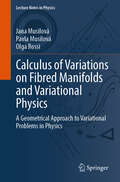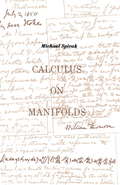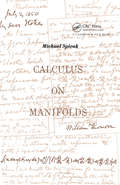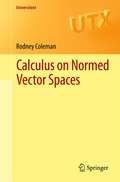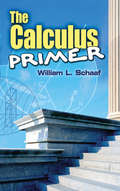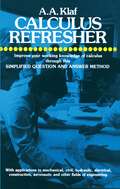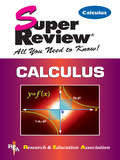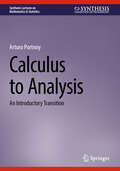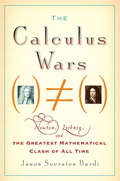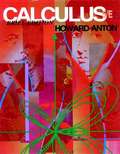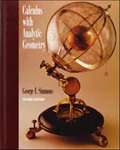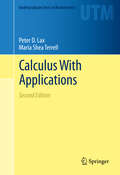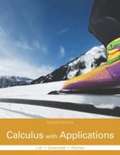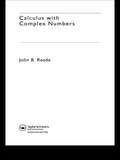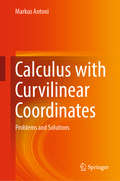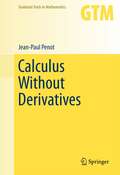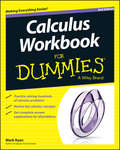- Table View
- List View
Calculus of Variations on Fibred Manifolds and Variational Physics: A Geometrical Approach to Variational Problems in Physics (Lecture Notes in Physics #1033)
by Jana Musilová Pavla Musilová Olga RossiThis book presents modern variational calculus in mechanics and field theories with applications to theoretical physics. It is based on modern mathematical tools, specifically fibred spaces and their jet prolongations, which operate with vector fields and differential forms on foundational structures. The book systematically explains Lagrangian and Hamiltonian mechanics and field theory, with a focused exploration of the underlying structures. Additionally, it addresses the well-known inverse problem of calculus of variations and provides examples illustrating key variational physical theories. The text is complemented by solved examples from physics and includes exercises designed to help readers master the subject. Aimed at PhD students, postdocs, and interested researchers, this book assumes prior knowledge of mathematical analysis, linear and multilinear algebra, as well as elements of general and theoretical physics for effective engagement with the discussion.
Calculus On Manifolds
by Michael SpivakThis little book is especially concerned with those portions of ”advanced calculus” in which the subtlety of the concepts and methods makes rigor difficult to attain at an elementary level. The approach taken here uses elementary versions of modern methods found in sophisticated mathematics. The formal prerequisites include only a term of linear algebra, a nodding acquaintance with the notation of set theory, and a respectable first-year calculus course (one which at least mentions the least upper bound (sup) and greatest lower bound (inf) of a set of real numbers). Beyond this a certain (perhaps latent) rapport with abstract mathematics will be found almost essential.
Calculus On Manifolds: A Modern Approach To Classical Theorems Of Advanced Calculus
by Michael SpivakThis little book is especially concerned with those portions of ?advanced calculus? in which the subtlety of the concepts and methods makes rigor difficult to attain at an elementary level. The approach taken here uses elementary versions of modern methods found in sophisticated mathematics. The formal prerequisites include only a term of linear algebra, a nodding acquaintance with the notation of set theory, and a respectable first-year calculus course (one which at least mentions the least upper bound (sup) and greatest lower bound (inf) of a set of real numbers). Beyond this a certain (perhaps latent) rapport with abstract mathematics will be found almost essential.
Calculus On Manifolds
by Michael SpivakThis little book is especially concerned with those portions of "advanced calculus" in which the subtlety of the concepts and methods makes rigor difficult to attain at an elementary level. The approach taken here uses elementary versions of modern methods found in sophisticated mathematics. The formal prerequisites include only a term of linear algebra, a nodding acquaintance with the notation of set theory, and a respectable first-year calculus course (one which at least mentions the least upper bound (sup) and greatest lower bound (inf) of a set of real numbers). Beyond this a certain (perhaps latent) rapport with abstract mathematics will be found almost essential.<P><P> Advisory: Bookshare has learned that this book offers only partial accessibility. We have kept it in the collection because it is useful for some of our members. To explore further access options with us, please contact us through the Book Quality link on the right sidebar. Benetech is actively working on projects to improve accessibility issues such as these.
Calculus on Normed Vector Spaces (Universitext)
by Rodney ColemanThis book serves as an introduction to calculus on normed vector spaces at a higher undergraduate or beginning graduate level. The prerequisites include basic calculus and linear algebra, as well as a certain mathematical maturity. All the important topology and functional analysis topics are introduced where necessary. In its attempt to show how calculus on normed vector spaces extends the basic calculus of functions of several variables, this book is one of the few textbooks to bridge the gap between the available elementary texts and high level texts. The inclusion of many non-trivial applications of the theory and interesting exercises provides motivation for the reader.
The Calculus Primer
by William L. SchaafComprehensive but concise, this introduction to differential and integral calculus covers all the topics usually included in a first course. The straightforward development places less emphasis on mathematical rigor, and the informal manner of presentation sets students at ease. Many carefully worked-out examples illuminate the text, in addition to numerous diagrams, problems, and answers.Bearing the needs of beginners constantly in mind, the treatment covers all the basic concepts of calculus: functions, derivatives, differentiation of algebraic and transcendental functions, partial differentiation, indeterminate forms, general and special methods of integration, the definite integral, partial integration, and other fundamentals. Ample exercises permit students to test their grasp of subjects before moving forward, making this volume appropriate not only for classroom use but also for review and home study.
Calculus Problems (UNITEXT #101)
by Filippo Mari Marco Baronti Robertus Putten Irene VenturiThis book, intended as a practical working guide for students in Engineering, Mathematics, Physics, or any other field where rigorous calculus is needed, includes 450 exercises. Each chapter starts with a summary of the main definitions and results, which is followed by a selection of solved exercises accompanied by brief, illustrative comments. A selection of problems with indicated solutions rounds out each chapter. A final chapter explores problems that are not designed with a single issue in mind but instead call for the combination of a variety of techniques, rounding out the book's coverage. Though the book's primary focus is on functions of one real variable, basic ordinary differential equations (separation of variables, linear first order and constant coefficients ODEs) are also discussed. The material is taken from actual written tests that have been delivered at the Engineering School of the University of Genoa. Literally thousands of students have worked on these problems, ensuring their real-world applicability.
Calculus Refresher (Dover Books on Mathematics)
by A. A. KlafThis book is unique in English as a refresher for engineers, technicians, and students who either wish to brush up their calculus or find parts of calculus unclear. It is not an ordinary textbook. It is, instead, an examination of the most important aspects of integral and differential calculus in terms of the 756 questions most likely to occur to the technical reader. It provides a very easily followed presentation and may also be used as either an introductory or supplementary textbook. The first part of this book covers simple differential calculus, with constants, variables, functions, increments, derivatives, differentiation, logarithms, curvature of curves, and similar topics. The second part covers fundamental ideas of integration (inspection, substitution, transformation, reduction) areas and volumes, mean value, successive and partial integration, double and triple integration. In all cases the author stresses practical aspects rather than theoretical, and builds upon such situations as might occur. A 50-page section illustrates the application of calculus to specific problems of civil and nautical engineering, electricity, stress and strain, elasticity, industrial engineering, and similar fields. 756 questions answered. 566 problems to measure your knowledge and improvement; answers. 36 pages of useful constants, formulae for ready reference. Index.
Calculus Super Review (Super Reviews Study Guides)
by Editors of REAGet all you need to know with Super Reviews! Each Super Review is packed with in-depth, student-friendly topic reviews that fully explain everything about the subject. The Calculus I Super Review includes a review of functions, limits, basic derivatives, the definite integral, combinations, and permutations. Take the Super Review quizzes to see how much you've learned - and where you need more study. Makes an excellent study aid and textbook companion. Great for self-study! DETAILS - From cover to cover, each in-depth topic review is easy-to-follow and easy-to-grasp - Perfect when preparing for homework, quizzes, and exams! - Review questions after each topic that highlight and reinforce key areas and concepts - Student-friendly language for easy reading and comprehension - Includes quizzes that test your understanding of the subject
Calculus to Analysis: An Introductory Transition (Synthesis Lectures on Mathematics & Statistics)
by Arturo PortnoyThis book addresses the analysis of functions of a real variable and transitions from the standard calculus sequence to mathematical analysis. The author presents the limits and convergence of sequences of functions, illustrates the limitations of the Riemann integral, and discusses the need for a new integral: the Lebesgue integral. The fundamental concepts of the theory of calculus of one variable is presented in addition to limits, continuity, derivatives and its applications, and integrals and their applications. The tone and language of the book is kept as informal as possible along with the descriptions and examples to aid learning. The book is concise and presents single variable advanced calculus leading up to Fourier analysis. In addition, the book sets up sufficient background for a course in measure theory and Lebesgue integration.
Calculus, Volume 1
by Tom M. ApostolAn introduction to the Calculus, with an excellent balance between theory and technique. Integration is treated before differentiation--this is a departure from most modern texts, but it is historically correct, and it is the best way to establish the true connection between the integral and the derivative. Proofs of all the important theorems are given, generally preceded by geometric or intuitive discussion. This Second Edition introduces the mean-value theorems and their applications earlier in the text, incorporates a treatment of linear algebra, and contains many new and easier exercises. As in the first edition, an interesting historical introduction precedes each important new concept.
The Calculus Wars: Newton, Leibniz, and the Greatest Mathematical Clash of All Time
by Jason Socrates BardiThis vibrant and gripping history ultimately exposes how these twin mathematical giants (Newton, Leibniz) were proud, brilliant, at times mad, and in the end completely human.
Calculus with Analytic Geometry (Advanced Placement, 8th Edition)
by Ron Larson Robert P. Hostetler Bruce H. EdwardsCalculus, Eighth Edition, offers comprehensive coverage of the material required by students in a three-semester or four-quarter calculus course, including carefully stated theories and proofs.
Calculus With Analytic Geometry, Brief Edition
by Howard AntonThe aim of this major revision is to create a contemporary text which incorporates the best features of calculus reform yet preserves the main structure of an established and well-tested calculus course. The multivariate calculus material is completely rewritten to include the concept of a vector field and focuses on major physics and engineering applications of vector analysis. Covers such new topics as Jacobians, Kepler's laws, conics in polar coordinates and parametric representation of surfaces. Contains expanded use of calculator computations and numerous exercises.
Calculus With Analytic Geometry (Second Edition)
by George F. SimmonsIt is a curious fact that people who write thousand-page textbooks still seem to find it necessary to write prefaces to explain their purposes. Enough is enough, one would think. However, every textbook--and this one is no exception--is both an expression of dissatisfaction with existing books and a statement by the author of what he thinks such a book ought to contain, and a preface offers one last chance to be heard and understood.
Calculus with Analytic Geometry (Seventh Edition)
by Ron Larson Robert P. Hosteller Bruce H. EdwardsThis Seventh Edition continues to offer instructors and students a text that is pedagogically sound, mathematically precise, and comprehensible.
Calculus With Applications (Undergraduate Texts in Mathematics)
by Peter D. Lax Maria Shea TerrellThis new edition of Lax, Burstein, and Lax's Calculus with Applications and Computing offers meaningful explanations of the important theorems of single variable calculus. Written with students in mathematics, the physical sciences, and engineering in mind, and revised with their help, it shows that the themes of calculation, approximation, and modeling are central to mathematics and the main ideas of single variable calculus. This edition brings the innovation of the first edition to a new generation of students. New sections in this book use simple, elementary examples to show that when applying calculus concepts to approximations of functions, uniform convergence is more natural and easier to use than point-wise convergence. As in the original, this edition includes material that is essential for students in science and engineering, including an elementary introduction to complex numbers and complex-valued functions, applications of calculus to modeling vibrations and population dynamics, and an introduction to probability and information theory.
Calculus with Applications (10th Edition)
by Margaret L. Lial Raymond N. Greenwell Nathan P. RitcheyCalculus with Applications, Tenth Edition by Lial, Greenwell, and Ritchey, is our most applied text to date, making the math relevant and accessible for students of business, life science, and social sciences. Current applications, many using real data, are incorporated in numerous forms throughout the book, preparing students for success in their professional careers. With this edition, students will find new ways to get involved with the material, such as "Your Turn" exercises and "Apply It" vignettes that encourage active participation.
Calculus With Applications (Eleventh Edition)
by Margaret L. Lial Raymond N. Greenwell Nathan P. RitcheyCalculus with Applications is a thorough, applications-oriented text for students majoring in business, management, economics, or the life or social sciences.
Calculus with Complex Numbers
by John B. ReadeThis practical treatment explains the applications complex calculus without requiring the rigor of a real analysis background. The author explores algebraic and geometric aspects of complex numbers, differentiation, contour integration, finite and infinite real integrals, summation of series, and the fundamental theorem of algebra. The Residue Theo
Calculus with Curvilinear Coordinates: Problems and Solutions
by Markus AntoniThis book presents problems and solutions in calculus with curvilinear coordinates. Vector analysis can be performed in different coordinate systems, an optimal system considers the symmetry of the problem in order to reduce calculatory difficulty. The book presents the material in arbitrary orthogonal coordinates, and includes the discussion of parametrization methods as well as topics such as potential theory and integral theorems. The target audience primarily comprises university teachers in engineering mathematics, but the book may also be beneficial for advanced undergraduate and graduate students alike.
Calculus with Vectors (Springer Undergraduate Texts in Mathematics and Technology)
by Jay S. TreimanCalculus with Vectors grew out of a strong need for a beginning calculus textbook for undergraduates who intend to pursue careers in STEM fields. The approach introduces vector-valued functions from the start, emphasizing the connections between one-variable and multi-variable calculus. The text includes early vectors and early transcendentals and includes a rigorous but informal approach to vectors. Examples and focused applications are well presented along with an abundance of motivating exercises. The approaches taken to topics such as the derivation of the derivatives of sine and cosine, the approach to limits and the use of "tables" of integration have been modified from the standards seen in other textbooks in order to maximize the ease with which students may comprehend the material. Additionally, the material presented is intentionally non-specific to any software or hardware platform in order to accommodate the wide variety and rapid evolution of tools used. Technology is referenced in the text and is required for a good number of problems.
Calculus Without Derivatives (Graduate Texts in Mathematics #266)
by Jean-Paul PenotCalculus Without Derivatives expounds the foundations and recent advances in nonsmooth analysis, a powerful compound of mathematical tools that obviates the usual smoothness assumptions. This textbook also provides significant tools and methods towards applications, in particular optimization problems. Whereas most books on this subject focus on a particular theory, this text takes a general approach including all main theories. In order to be self-contained, the book includes three chapters of preliminary material, each of which can be used as an independent course if needed. The first chapter deals with metric properties, variational principles, decrease principles, methods of error bounds, calmness and metric regularity. The second one presents the classical tools of differential calculus and includes a section about the calculus of variations. The third contains a clear exposition of convex analysis.
Calculus Workbook For Dummies
by Mark RyanYour light-hearted, practical approach to conquering calculus Does the thought of calculus give you a coronary? You aren't alone. Thankfully, this new edition of Calculus Workbook For Dummies makes it infinitely easier. Focusing "beyond the classroom," it contains calculus exercises you can work on that will help to increase your confidence and improve your skills. This hands-on, friendly guide gives you hundreds of practice problems on limits, vectors, continuity, differentiation, integration, curve-sketching, conic sections, natural logarithms, and infinite series. Calculus is a gateway and potential stumbling block for students interested in pursuing a career in math, science, engineering, finance, and technology. Calculus students, along with math students in nearly all disciplines, benefit greatly from opportunities to practice different types of problems--in the classroom and out. Calculus Workbook For Dummies takes you step-by-step through each concept, operation, and solution, explaining the "how" and "why" in plain English, rather than math-speak. Through relevant instruction and practical examples, you'll soon learn that real-life calculus isn't nearly the monster it's made out to be. Master differentiation and integration Use the calculus microscope: limits Analyze common functions Score your highest in calculus Complete with tips for problem-solving and traps to avoid, Calculus Workbook For Dummies is your sure-fire weapon for conquering calculus!
